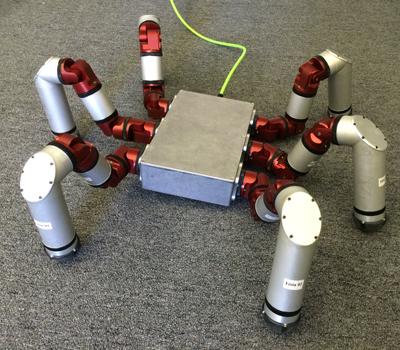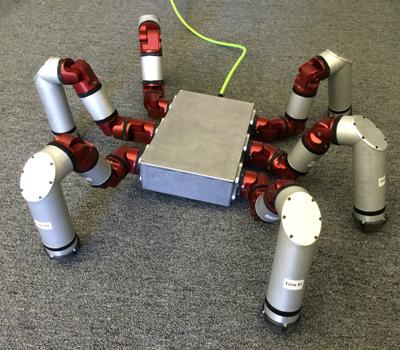January 19, 2015


Researchers at Carnegie Mellon University's Robotics Institute have leveraged their locomoting modular snake robot design expertise into a six-legged, snaky-limbed walking robot that can be reconfigured to meet users' needs. Not only will this modular system enable completely new robot designs, it will also help speed up the pace of development and enable more flexible traditional industrial robots, says team leader and inventor Howie Choset.
Although it looks more like a six-legged insect, the Snake Monster robot's name reflects the fact that its legs, and its modularity, derive from Choset's Biorobotics Lab's work in building snake-like robots, like the one we told you about a couple years ago in a robot snake slideshow. At that time, the CMU robots' moves were the most sophisticated we'd seen in mechanical snakes. They can slither, roll, swim, and climb straight up, as well as spiral forward to fit through a narrow space such as a pipe, or wind themselves around a vertical pole or a tree trunk and slither right on up it, as you can see in this video.
All these gaits give the snake bots the ability to navigate a broader range of physical environments than other robots and adapt to changing terrain, envisioned by their makers primarily as rescue robots in post-disaster situations. During its research on gaits, the team successfully mimicked all of a biological snake's gaits and developed some that real snakes can't do. This has been achieved through carefully coordinating the metal segments, or joints, that comprise each snake, containing electronics and motors. Other applications include inspection of refineries, power plants and sewers, and archaeological exploration.
The Snake Monster was developed in only six months, funded by the DARPA Maximum Mobility and Manipulation (M3) program. M3 aims to speed up the design and construction of mobile robots, and improve their ability to navigate through natural environments and manipulate objects. Based on their past experience, Choset's team designed and built small modules and created an Ethernet-based system architecture that controls a wide variety of robotic configurations built up from them. The system can be easily programmed.
Choset's team also developed a series-elastic actuator. Placed in each joint, this motor that has a spring in series with its output shaft allows simultaneous control of position, torque, and velocity, which in turn enables compliant motions via a simple alternating tripod walking gait. When the robot travels over rough ground, the springs let its legs conform to the environment like an animal's gait would, instead of the operator being required to plan each footstep. Watch a video of Snake Monster's moves:
The researchers are designing more modules to enable the assembly of even more types of walking robots. These include wheels, tank-like treads, and force-sensing feet. Choset says a system for building robots that can be easily reconfigured and are easy to program will help make robot designs more flexible, more robust, and less expensive. As we've discussed in Design News, engineers are developing multiple technologies to create modular, reconfigurable, and self-reconfigurable robots, as well as self-assembling/reassembling robots, for use as rescue robots and planetary explorers, or even to replace the manufacturing processes of some consumer products.
Design engineers and professionals, the West Coast's most important design, innovation, and manufacturing event, Pacific Design & Manufacturing, is taking place in Anaheim, Feb. 10-12, 2015. A Design News event, Pacific Design & Manufacturing is your chance to meet qualified suppliers, get hands-on access to the latest technologies, be informed from a world-class conference program, and expand your network. (You might even meet a Design News editor.) Learn more about Pacific Design & Manufacturing here.
Ann R. Thryft is senior technical editor, materials & assembly, for Design News. She's been writing about manufacturing- and electronics-related technologies for 25 years, covering manufacturing materials & processes, alternative energy, machine vision, and all kinds of communications.
Related posts:
About the Author(s)
You May Also Like



